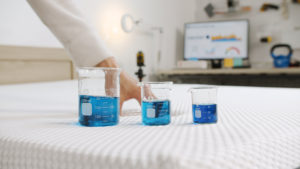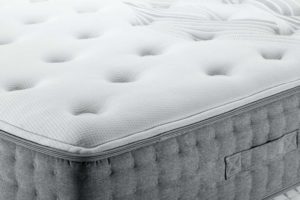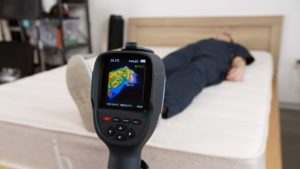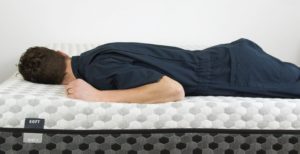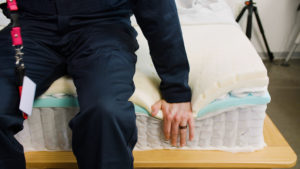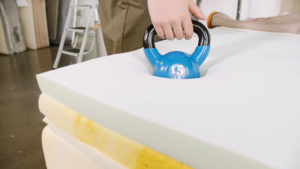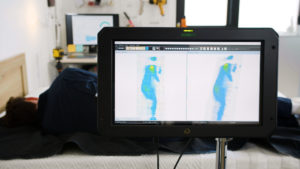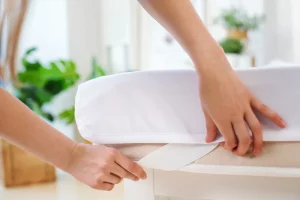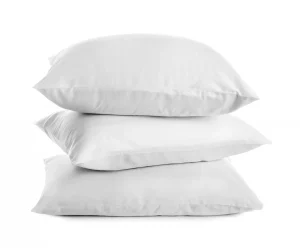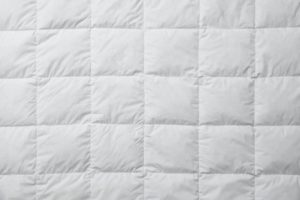Off-Gassing
New mattresses sometimes emit an odor during the off-gassing process, which is the result of volatile organic compounds (VOCs). VOCs are byproducts of mattress manufacturing. While they may smell bad, they’re generally considered harmless.
Off-gassing is especially common in mattress-in-a-box mattresses that are vacuum-sealed and packaged soon after production. Additionally, certain mattress materials are more prone to off-gassing odors than others.
Shopping around for a new mattress can take time, and if you trial different mattresses, that’s more time required for off-gassing. At the Test Lab, we try to take some of the guesswork out and provide product-tested recommendations.
We’ll cover what occurs during this process, who off-gassing affects, which materials are most likely to retain smells, and the scientific approach we use in our evaluations.
What Is Off-Gassing?
Most new mattresses emit an initial odor known as off-gassing. Off-gassing occurs when you remove a mattress from its packaging for the first time. It is especially noticeable with mattress-in-a-box mattresses because vacuum sealing them traps chemical byproducts until you open the package in your home.
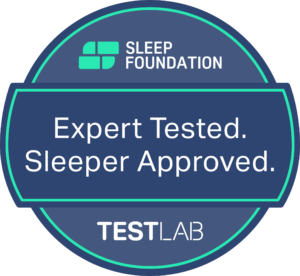

Off-gassing odors pose no known serious health risks, but they can be unpleasant. In the Test Lab, we measure the concentration of these odors in the room, relative to a control room, and study how long they last. Our assessments judge new mattresses on both the strength and persistence of their scents. A higher numerical rating means the new mattress smell is less severe and dissipates relatively quickly.
The term off-gassing typically refers to volatile organic compound (VOC) emissions. VOCs are a specific byproduct of the synthetic foam manufacturing process, so they’re most common in mattresses that contain polyfoam or memory foam. However, we also use the term off-gassing loosely to refer to any scent given off by a new mattress, topper, pillow, or other sleep product.
Who Should Care About Off-Gassing?
Off-gassing smells are unpleasant for most sleepers, but they may be more problematic for some than for others. If you’re especially sensitive to scents, a bed with strong off-gassing odors may cause unwanted symptoms, such as headaches, nausea, or dizziness. Individuals with respiratory issues, such as asthma or allergies, could also experience irritation of the airway and difficulty breathing.
However, off-gassing may not be a concern for those who don’t mind the smell or who have the time and space to allow the mattress to air out before use.
Mattress Materials and Off-Gassing
Off-gassing depends on materials. Synthetic substances, such as memory foam and polyfoam, are more prone to off-gassing than metal coils or natural materials. We’ll break down each major mattress material and its potential for off-gassing odor in more detail.
| Material | Description | Feel | Off-Gassing Performance |
|---|---|---|---|
| Memory Foam | Memory foam is a unique viscoelastic foam originally developed by NASA. This material molds to the body in response to weight and warmth and is most common in comfort and transition layers. | Memory foam is highly contouring and provides excellent pressure relief by cushioning the body proportional to its weight. Although memory foam can sometimes sleep hot, newer formulations often incorporate cooling technology designed to improve temperature control. | As a synthetic material, memory foam tends to emit noticeable off-gassing odors. However, materials with certifications from GREENGUARD Gold, OEKO-TEX, CertiPUR-US, or eco-INSTITUT are independently tested for content and emission standards, thereby reducing the potential for severe off-gassing. |
| Polyfoam | Polyfoam refers to any formulation of polyurethane-based foam. Different varieties vary in their characteristics, making the material suitable for comfort, transition, and support layers. | The feel of polyfoam depends on the specific formulation. It often falls somewhere between memory foam and latex in terms of contouring and responsiveness, balancing breathability, and conforming. | Polyfoam is a synthetic material with a high potential for off-gassing odors. Independent certification can provide reassurance that the material has tested free of certain harmful chemicals and has passed emissions tests. |
| Latex | Natural latex is made from the sap of rubber trees, while synthetic latex uses petrochemicals. Latex can be produced via either the Dunlop or the Talalay process, affecting the material’s feel and performance. Manufacturers may incorporate latex in the comfort or transitional layers of hybrid or all-foam models, but you can also find all-latex mattresses. | Latex provides moderate contouring and notable responsiveness, offering some pressure relief without sacrificing ease of movement. | Since truly natural latex is free from synthetic components, it should not let off odors associated with VOCs. However, it may emit a slight natural or rubbery smell. Synthetic latex is more likely to have distinct VOC-related off-gassing odors. |
| Microcoils | Microcoil systems consist of a thin layer of small springs. In contrast to the substantial coil layers in hybrid and innerspring support cores, microcoils typically measure just a few inches thick. This construction technique is most common in multi-layered comfort systems and transitional layers. | With a springy feel and breathable design, microcoils add responsiveness while allowing air to circulate. | Metal coils do not emit significant off-gassing. Even pocketed coils individually wrapped in fabric tend to produce minimal to no off-gassing odor. |
Off-Gassing by Mattress Type
Mattresses are typically categorized by the materials in the support core, which is a thick, sturdy layer that serves as the base. We’ll outline five of the most popular mattress types and discuss their performance in terms of off-gassing.
All-Foam: All-foam mattresses consist of a polyfoam support core with a comfort system made of memory foam, polyfoam, latex, or a combination of materials. Since most all-foam models use exclusively synthetic foam, they generally have a high potential for off-gassing.
Latex: Latex mattresses contain a support core and comfort system made from latex. Most models use natural latex, which should produce minimal odor due to its lack of chemical byproducts. That said, models with synthetic or blended latex may emit similar off-gassing odors to all-foam models.
Innerspring: Traditional innerspring mattresses include a bouncy core of metal springs with little surface padding. Once the dominant design in the mattress industry, innerspring models are becoming less common. This type of mattress is not prone to significant off-gassing because it uses little to no synthetic foam, and airflow through the coil system helps odors dissipate quickly.
Hybrid: A hybrid mattress contains a support core made from metal springs topped with a thick comfort system made from memory foam, polyfoam, latex, microcoils, or other materials. Thicker comfort systems generally enhance pressure relief and motion isolation compared to traditional innerspring models.
The overall level of off-gassing depends on a hybrid’s materials and construction. Ample layers of polyfoam or memory foam can increase off-gassing odors, while models that use natural latex comfort systems may have virtually no discernable scent. Most hybrids retain fewer off-gassing odors than the average all-foam model because of their reduced synthetic content and enhanced airflow.
Airbed: Airbeds use air chamber support units that can be emptied or filled to adjust the firmness level. Most also include a layer of memory foam or polyfoam as a comfort system. While the air chambers themselves may produce a slight odor, an airbed’s off-gassing potential is based primarily on the composition and thickness of its comfort layers.

How Do We Test for Off-Gassing?
We’ve developed a detailed methodology that we use to research, test, and review sleep products. For mattresses, this includes assigning an off-gassing rating. To generate a score that takes into account subjective and objective analyses, our testing team performs two tests: a smell test and a VOC test.
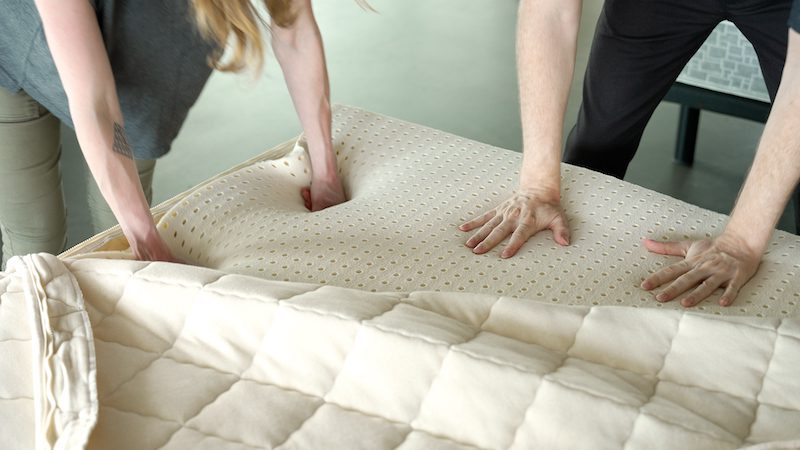
Body Test – Smell Test
The smell test is a subjective evaluation conducted by the testing team. With multiple team members in the room, we unbox the new mattress and place it on a bed frame. Each participant notes their initial impressions of the odor upon unboxing. We then check it again after 10 minutes, 1 hour, 3 hours, and 24 hours to record any changes, focusing on specific criteria:
- Strength of the odor
- What the odor smells like, including any recognizable qualities
- How far away the odor is detectable
- Perceived odors around the mattress and when smelling it directly
This assessment represents a realistic measure of how customers may experience off-gassing in their homes. A high score on this test indicates minimal perceivable odor that fades quickly.
To make this test as unbiased as possible, we institute controls, including reinforcing the bed base to prevent unnecessary movement, using the same testers each time, following consistent unboxing and storage protocols, and testing each model in the same space with equivalent ventilation and distance from the ground for the first 24 hours.
VOC Test
During this assessment, we measure the amount of VOCs given off during and after the unboxing process using a VOC meter. This test provides valuable data that allows us to more directly compare off-gassing performance between models.
Immediately after unboxing, we take readings on top of and around the mattress. When we perform the smell test detailed above, we also use the VOC meter to measure the air at the surface of the bed and in the surrounding area. We recheck at the 10-minute, 1-hour, 3-hour, and 24-hour marks.
For consistency across our evaluations, we measure the VOC content of the testing area before unboxing to establish a baseline and detect changes attributed to off-gassing. We also utilize the same VOC meter settings and positioning for every test, and we take measurements in the same locations using consistent methods.
Learn more about the Test Lab at the link below.

Frequently Asked Questions About Off-Gassing
What can I do about my bed’s degree of off-gassing?
The key to reducing off-gassing odor is ventilation and time. Give your mattress plenty of time to air out in a well-ventilated room. This ensures your bed can release the majority of its off-gassing odor before you sleep on it for the first time.
Many new mattresses need at least a few hours to air out. You can increase airflow in your bedroom by opening windows or using fans to help speed up the release of off-gassing odors.
What type of mattress is best in terms of off-gassing?
Natural latex mattresses, hybrids, and traditional innerspring models usually have the lowest potential for off-gassing. Conversely, beds constructed with more synthetic materials generally have stronger off-gassing odors.
If you enjoy the feel of foam but are worried about off-gassing, you might consider a model made with certified materials. Common certifications, such as CertiPUR-US, OEKO-TEX, GREENGUARD Gold, and eco-INSTITUT, verify that materials have passed independent content and emissions tests.
How long does off-gassing usually last?
The majority of off-gassing odors dissipate within a few hours of unpacking the mattress. However, you may be able to smell traces for several days to a few weeks, particularly if the model contains primarily synthetic foam.
Are there any health risks associated with mattress off-gassing?
For most sleepers, the compounds emitted during off-gassing are generally harmless. VOCs associated with synthetic foam do not pose major known health risks, but they may be irritating for sleepers with respiratory conditions or chemical sensitivities. For those who are sensitive to strong odors, off-gassing may cause temporary symptoms, such as headache, nausea, or dizziness. However, for most individuals, the biggest concern is the unpleasant smell.




